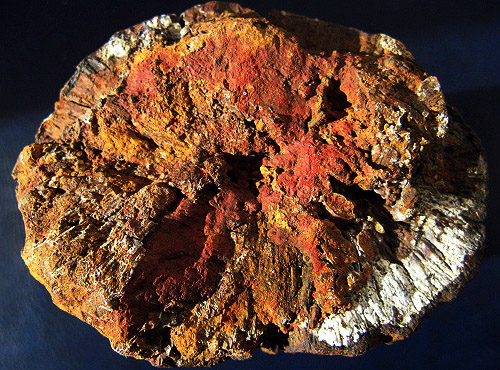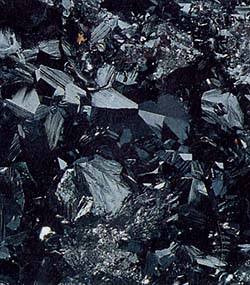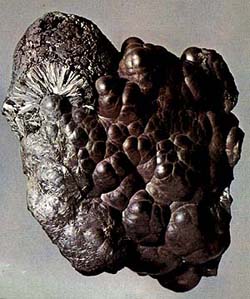Oxides and hydroxides: hematite (Bloodstone)
 Diagnostic Card.
Diagnostic Card.
The photo kidney-shaped aggregates (Egremont, Cumberland, Great Britain). Below: hematite crystals, which are known as the "iron shine".
Fe 2 O 3
Crystal system trigonal
6.5 Hardness
The proportion of 5.2-5.3
Cleavage is absent
fracture conchoidal
Color from red to black
Color powder brownish-red
shine metal

 The names of the iron ore formed by their belonging to a particular class of chemical compounds (oxide, silicate, sulphide) or mineral composition (hematite, limonite). Hematite crystals in the form of iron called a sheen, fine-grained aggregates - hematite. Iron luster (iron oxide), hardness 6,5-6. Shine metal, opaque. Color grayish black with colorful tarnish. The bar is red. Fracture conchoidal. Cleavage is absent. Forms crystals belonging to the trigonal system, are very diverse.
The names of the iron ore formed by their belonging to a particular class of chemical compounds (oxide, silicate, sulphide) or mineral composition (hematite, limonite). Hematite crystals in the form of iron called a sheen, fine-grained aggregates - hematite. Iron luster (iron oxide), hardness 6,5-6. Shine metal, opaque. Color grayish black with colorful tarnish. The bar is red. Fracture conchoidal. Cleavage is absent. Forms crystals belonging to the trigonal system, are very diverse.
Hematite: Color steel gray with a red tint. Presented dense granular or fibrous aggregates. Kidney-shaped selection, consisting of individuals and tonkoluchistyh covered with shiny reddish crust, called "red glass head." Particularly dense species - Bloodstone - polished and engraved for jewelry. Powder from crushed bloodstone used for polishing gold jewelry.
Earthy variety - red ocher has metallovidnogo shape and is used as a dye. Hematite ore found in metamorphic strata of ferruginous quartzite in the form of solid deposits and ore veins, as well as in the form of "micaceous hematite" - in skarns. Deposits: in Canada, the USA, Brazil, CIS.

Hematite, Slavic region, Donbass, south-east of Ukraine, CIS.
, Donbass, minerals (27 January 2013, 9:40).
When processing hematite stains the cooling water in the blood-red color, hence its name (from the Greek haima -. Blood) and a synonym for dense species - Bloodstone. Brilliant lamellar hematite crystals called spekulyaritom (from the Greek specula -. Contemplation) - in ancient times they were used as mirrors. In mineralogy, well-formed crystals called "iron shine", and fine-grained aggregates - "hematite". The thin pieces of hematite shines red in polished form has a bright, vibrant shine.
When processing hematite stains the cooling water in the blood-red color, hence its name (from the Greek haima -. Blood) and a synonym for dense species - Bloodstone. Brilliant lamellar hematite crystals called spekulyaritom (from the Greek specula -. Contemplation) - in ancient times they were used as mirrors. In mineralogy, well-formed crystals called "iron shine", and fine-grained aggregates - "hematite". The thin pieces of hematite shines red in polished form has a bright, vibrant shine.
 Hematite - a mineral of black color, often with a rosy glow, crystallizes in the trigonal system. Often crystals flattened form ( "iron shine or oligist"), or plate and arranged like the petals of a rose ( "Iron Rose"). Occurs as either more or less dense masses, sometimes with the iridescent sheen on the surface or earthy red color clusters. In the latter case it is called hematite. It may also have oolitic addition or to form nodules.
Hematite - a mineral of black color, often with a rosy glow, crystallizes in the trigonal system. Often crystals flattened form ( "iron shine or oligist"), or plate and arranged like the petals of a rose ( "Iron Rose"). Occurs as either more or less dense masses, sometimes with the iridescent sheen on the surface or earthy red color clusters. In the latter case it is called hematite. It may also have oolitic addition or to form nodules.
Shine metal. Hard not to scratch the blade of the knife, but scratches quartz, apatite scratching himself. Hematite is very heavy, has no cleavage, brittle.
Diagnostic features.
Hematite refractories and heating acquires magnetic properties. Color powder dark red, which distinguishes it from other iron oxides (magnetite and ilmenite). Hematite can be confused with dark cassiterite. Imitation is sometimes made of pressed and sintered hematite fragments (ceramics).
Origin.
This mineral common in volcanic rocks, in pegmatites and hydrothermal veins, formed during the formation of granites and pegmatites. Very often a sedimentary origin, forming at partial recrystallization (diagenesis) limonite. In such cases, hematite may have oolitic concretions or addition.
Forms pseudomorphs after magnetite. In such a case it is called Martin. Material suitable for processing to occur in Cumberland (England), in Thuringia (Germany), on the Elbe, as well as in Norway, Sweden, Spain, Brazil, New Zealand, USA, CIS (Kazakhstan).
 Place of Birth.
Place of Birth.
The most important from the point of view of industrial development of the deposit associated with ferruginous quartzites (taconite). The largest of them - Lake Syuperior (USA), Quebec (Canada), as well as deposits in Venezuela and Angola. Deposits oolitic types found in Canada, in the state of Tennessee (USA) and in the Ukraine.
In Italy, the beautiful shape of the "iron shine" are in Rio Marina (Elba), as well as in Brazil, the state of Bahia, and in the UK in Cumberland. The most famous "iron roses" came from the Gotthard group in Val di Binn (Switzerland). But the largest of them, the size of a diameter of 15 cm, are derived from the state of Minas Gerais (Brazil).
In Brazil, there is another kind, strongly flattened, with a completely smooth surface, which received the name of specular. Very beautiful martity found in Canada and the United States, Twin Peaks (Utah) and in the area of Lake Superior.
Application.
Although not too high content of iron, hematite - one of the most important iron ore, due to its wide distribution. Red iron ore is used as a pigment, it is also used as a polishing powder. Although hematite jewelry is not in high demand it from ancient times (especially dense massive microcrystalline form with a remarkable brilliance) were used for decoration. It is used in jewelry, is used to insert in the rings, round beads and as a material for recessed engraving (intaglio).
Oxides and hydroxides: Romaneche
 Diagnostic Card.
Diagnostic Card.
Mn 5 O 10 * (Ba, H 2 O)
Hardness 4-6
The proportion of 4.4-4.7
Cleavage is absent
Black color
The color of the powder is brownish-black
Gloss or dull half-
Romaneche - barium-containing manganese hydroxide, similar in appearance to hematite "red head". Gloss semimetallic or dull. Opaque. Black color. Dash brownish-black. Fracture conchoidal, brittle. Cleavage is absent. Formed in sedimentary deposits.
The amorphous or cryptocrystalline, resigns grozdevidnye, kidney-shaped formation ( "black glass head"), is an earthy (wad), it forms a film dendrites. Important manganese ore. Additional points of manganese ore minerals should be noted pyrolusite, manganite, hausmannite, Brown, cryptomelane.
Place of Birth.
Deposits: CIS, Ghana, Congo, South Africa, India. The sample in the photo - a classic "black glass head" of the Westerwald, Hesse, Germany.
- Gatchell - "New Almadén snag" - arsenide and antimony sulfide (modern sulphosalts)
- Antimony - toxic metal (semi-metal) are widely used in industry, medicine and engineering
- Zirconium - a rare and non- metal and dangerous jewel in the oxide and salts
- Gold - yellow dangerous and toxic metal -date and accurate digital cable technology
- Sulphur - a golden-yellow toxic substance and a sign of volcanic activity
- Cadmium - a toxic uncirculated unknown wide range of people silvery metal
- Lead - a poisonous gray simulator silver metal and toxic metal snag
- Arsenic - poison classic medieval and modern poisoners and medicine in medicine
Toxic and hazardous radioactive rocks and minerals
** - Poisonous stones and minerals (obligatory check in chemical laboratory + clear indication of toxicity)
** - Radioactive rocks and minerals (obligatory check on a regular dosimeter + ban on the open sale of radioactivity in the event of more than 24 mR / hour + additional measures to protect the population)
Catalog minerals and gems in groups of the world
** - Poisonous stones and minerals
** - Radioactive rocks and minerals


Comments
Commenting, keep in mind that the content and the tone of your messages can hurt the feelings of real people, show respect and tolerance to his interlocutors, even if you do not share their opinion, your behavior in terms of freedom of speech and anonymity offered by the Internet, is changing not only virtual, but real world. All comments are hidden from the index, spam control.